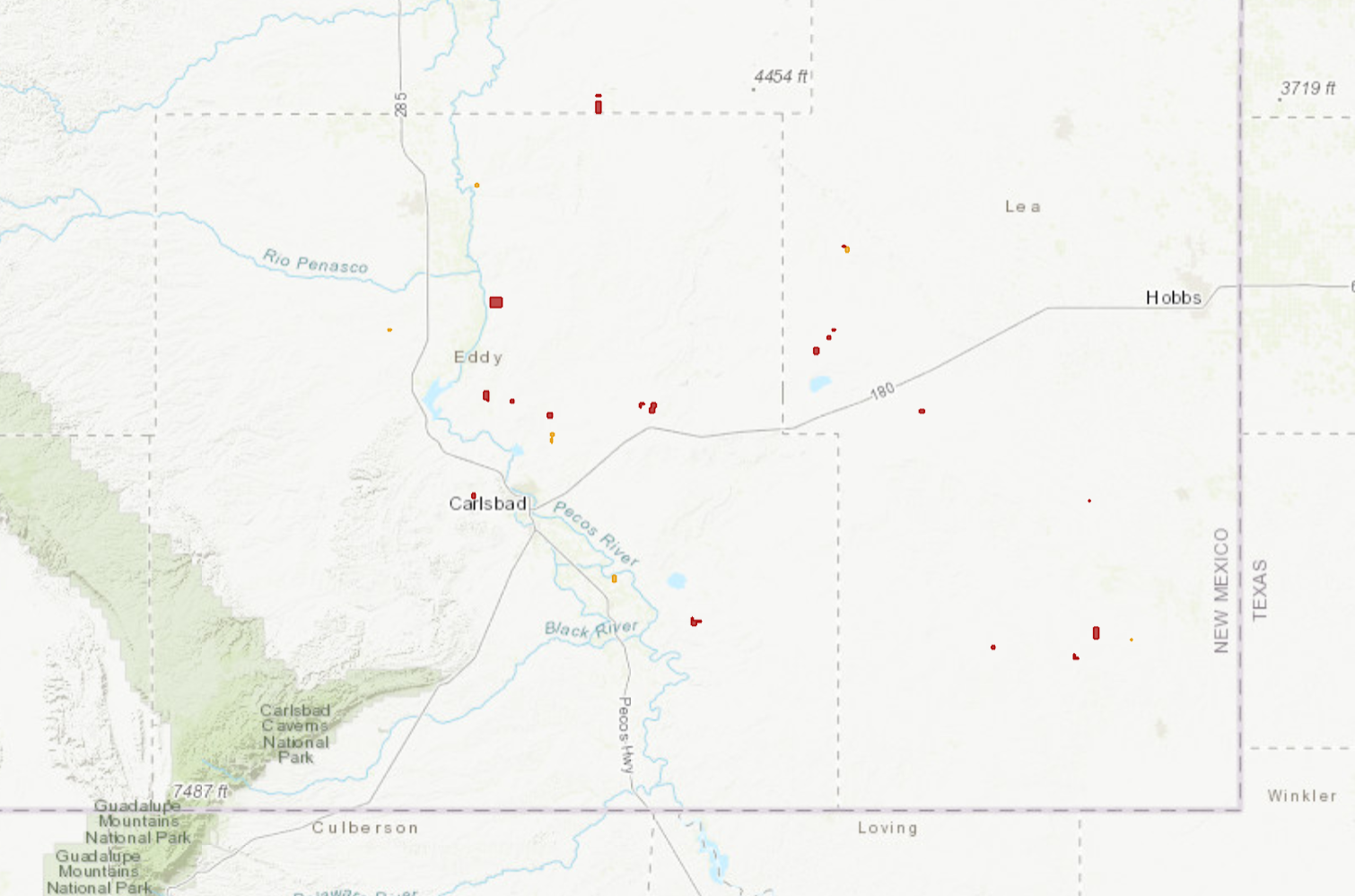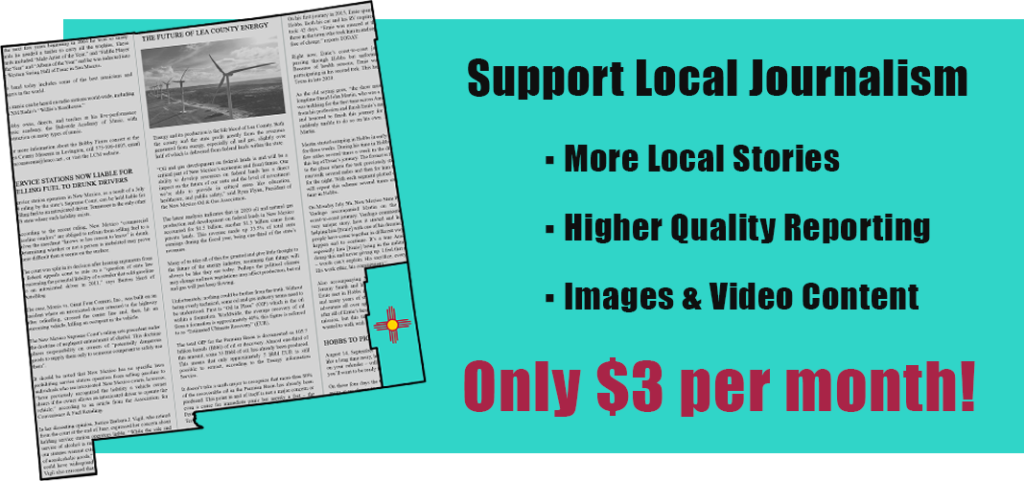
Almost 600 acres, comprising 12 parcels of federal public land in southeastern New Mexico and Oklahoma, may be leased by online auction to the oil and gas industry on November 30 by the U. S. Bureau of Land Management (BLM).
Approximately 75% of the land to be leased is located in Lea and Eddy counties – two parcels in Lea County and four in Eddy County. The BLM estimates that, if leased, the six parcels might be used for six wells that could produce approximately one million barrels of oil and almost six billion cubic feet of natural gas over the length of their economic lifetimes.
The standard leases, if granted, will be for ten years or “as long as oil and gas is produced”, with updated royalty and rental terms as conditions. The BLM’s management of oil and gas leasing has often been controversial in recent years. Conservationists and environmentalists repeatedly raise concerns about the potential negative impact caused by drilling on public lands. Disruption of habitat, emission of greenhouse gasses and water pollution are named as components of the negative impact.
Vocal about the possible negative impact is the Southeastern New Mexico organization Citizens Caring for the Future. The organization brings together “community members who support protecting our air, water and public health and safety during the current oil and gas boom in the Permian,” states the group’s website. Group spokesperson Kayley Shoup states about the BLM’s management of oil and gas leasing, “Not only does oil and gas production in the Permian have a profound impact on the climate, but it also greatly affects public and environmental health in the region. I fear we have no idea just how contaminated our water, land and therefore our bodies may be by these highly toxic and health harming fracking chemicals. It’s shameful that our health and well-being are up for sale.”
To allow stakeholders like Citizens Caring for the Future to raise concerns about the November 30 sale, the BLM has opened until September 13 a public protest period for individuals to file for record their opposition to the sale. The goal is to consult and engage with local communities and the public in general about oil and gas leasing decisions with the hope of ensuring that the best interests of all are taken into account before the lease sale takes place.
In addition to the current protest period, the BLM entertained technical comments about the proposed November sale between February 17 and March 20 of this year. Additionally, a comment period about the BLM’s environmental analysis took place between May 16 and June 15. The BLM periodically updates its regulations and policies related to oil and gas leasing to address environmental and social concerns. This procedure includes measures to improve transparency in lease sales, assess the environmental impacts of drilling and ensure that fair market value in lease sales is obtained.
In its published report about the November 30 proposed sale, the BLM contends that “…oil and gas operations on the lands proposed for lease would not have a ‘significant impact’ on the environment or public safety,” states a Current-Argus article written by Adrian Hedden. The report also indicates that air and water pollution would not “alone” be significantly impacted nor would seismic activity caused by humans, known as induced seismicity, be “…tied to disposal of the resulting wastewater” should oil and gas operations take place on the land.
The BLM estimates in its report that the resulting toxic wastewater from oil and gas operations on the proposed approximate 600 acres of federal public land would amount to approximately 3.5 million barrels in total, approximately 46,000 barrels monthly calculated over a projected 20-year production period.
Final Notice of Sale
The final notice of the sale was released on Monday, August 14. The sale must be held in accord with the 2022 Inflation Reduction Act (IRA). The IRA was signed into law by President Joe Biden.
Under the IRA the BLM is proposing new rules to update its procedures about the sale of federal land for oil and gas operations. The new rules will require lessors to attain “…approval for drilling or extraction operations to begin production after leasing the land,” states Hedden in his Current-Argus article. Operators will also pay a royalty rate of 16.67%, in comparison to the former 12.5%, on “produced oil and gas revenue”. Higher rental rates and the amount required for a minimum bid per acre – from $2.00 to $10.00 – will come into effect. Further, companies will have to pay bonding for the cleanup of abandoned wells in the amount of “…at least $150,000 per lease and at least $500,000 for a company’s leases statewide.”
Public comment about the new rules is being accepted by the BLM. To this end a public meeting was held in Albuquerque on Tuesday, August 22 and a virtual meeting is being organized for sometime in September. BLM Director Tracy Stone-Manning said in a statement, “This proposal to update BLM’s oil and gas program aims to ensure fairness to the taxpayer and balanced, responsible development as we continue to transition to a clean energy economy.”
Economic Impact of Not Leasing 12 Parcels Proposed for Sale on November 30
In its report the BLM states that should the federal government not lease the proposed 12 parcels for oil and gas production, negative effects on local economies will result. The report states, “This is because the oil and gas sector of the economy relies on both ongoing operational activities (development of existing leases) and new development opportunities (acquisition and development of new leases) to continue to provide local and regional jobs and revenue on a sustained basis.” Such is the case regarding the economic health of Lea County.
A Washington D. C. non-profit Resources for the Future released a report on Monday, August 21 that differs with the BLM’s analysis. In its study Resources for the Future contends that the Permian Basin’s economy “…could be threatened by its singular focus on oil and gas.” A Current-Argus article states,”Efforts to curb greenhouse gas emissions could reduce demand for fossil fuels, the report read, potentially leading to economic declines in southeast New Mexico and other fossil-fuel based regions throughout the U.S.”
More About the Potential November 30 Sale
Rocky Mountain Wild has provided an online map that shows the parcels the BLM plans to sell on November 30. Conflicts with “wildlife and natural areas” are noted. According to information posted at the Rocky Mountain Wild website, “Conflicts identified include parcels in other important habitat for terrestrial species of economic and recreational importance and parcels within an area identified as a priority corridor region for pronghorn.”
General information about the November 30 competitive oil and gas lease sale is available online. Information about how to comment about the proposed sale is available on BLM’s website.
Amidst the lingering questions about the BLM’s November 30 sale, the BLM is planning additional sales of federal public land for oil and gas operations. The agency has announced the proposed sale of 27 parcels in Chaves, Eddy and Lea counties, as well as Cheyenne County, Kansas – more than 6,000 acres – scheduled for the second quarter of 2024. Such sales are big money makers for the federal government. Noteworthy is the fact that the May 2023 sale of over 10,000 acres (45 parcels) in the same counties as the second quarter 2024 proposed sale brought in $78.8 million to the federal government.


